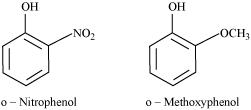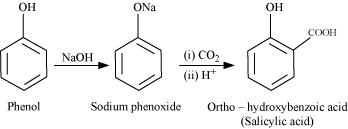Complete NCERT Solutions Guide
Access step-by-step solutions for all NCERT textbook questions
Welcome to the Chapter 11 - Alcohols Phenols and Ethers, Class 12 Chemistry NCERT Solutions page. Here, we provide detailed question answers for Chapter 11 - Alcohols Phenols and Ethers. The page is designed to help students gain a thorough understanding of the concepts related to natural resources, their classification, and sustainable development.
Our solutions explain each answer in a simple and comprehensive way, making it easier for students to grasp key topics Alcohols Phenols and Ethers and excel in their exams. By going through these Alcohols Phenols and Ethers question answers, you can strengthen your foundation and improve your performance in Class 12 Chemistry. Whether you’re revising or preparing for tests, this chapter-wise guide will serve as an invaluable resource.
Primary alcohol → (i), (ii), (iii)
Secondary alcohol → (iv), (v)
Tertiary alcohol → (vi)
In Williamson synthesis, an alkyl halide reacts with an alkoxide ion. Also, it is an SN2 reaction. In the reaction, alkyl halides should be primary having the least steric hindrance. Hence, an alkyl halide is obtained from ethanol and alkoxide ion from 3-methylpentan-2-ol.

Set (ii) is an appropriate set of reactants for the preparation of 1-methoxy-4-nitrobenzene.

In set (i), sodium methoxide (CH3ONa) is a strong nucleophile as well as a strong base. Hence, an elimination reaction predominates over a substitution reaction.
The alcohols given in (ii) and (vi) are allylic alcohols.
(i) 3-Chloromethyl-2-isopropylpentan-1-ol
(ii) 2, 5-Dimethylhexane-1, 3-diol
(iii) 3-Bromocyclohexanol
(iv) Hex-1-en-3-ol
(v) 2-Bromo-3-methylbut-2-en-1-ol
(i)

(ii)

(i)

(ii)

(iii)

(a)
(i)

Primary alcohols do not react appreciably with Lucas' reagent (HCl-ZnCl2) at room temperature.
(ii)

Tertiary alcohols react immediately with Lucas' reagent.
(b)
(i)

(ii)

(c)
(i)

(ii)


Resonance structure of the phenoxide ion

Resonance structures of p-nitrophenoxide ion

Resonance structures of o-nitrophenoxide ion
It can be observed that the presence of nitro groups increases the stability of phenoxide ion.
(i) Reimer-Tiemann reaction

(ii) Kolbe's reaction

(i) 2, 2, 4-Trimethylpentan-3-ol
(ii) 5-Ethylheptane-2, 4-diol
(iii) Butane-2, 3-diol
(iv) Propane-1, 2, 3-triol
(v) 2-Methylphenol
(vi) 4-Methylphenol
(vii) 2, 5-Dimethylphenol
(viii) 2, 6-Dimethylphenol
(ix) 1-Methoxy-2-methylpropane
(x) Ethoxybenzene
(xi) 1-Phenoxyheptane
(xii) 2-Ethoxybutane
Chlorobenzene is fused with NaOH (at 623 K and 320 atm pressure) to produce sodium phenoxide, which gives phenol on acidification.

The mechanism of hydration of ethene to form ethanol involves three steps.
Step 1:
Protonation of ethene to form carbocation by electrophilic attack of H3O+:

(i) By acid-catalyzed hydration of ethylbenzene (styrene), 1-phenylethanol can be synthesized.

(ii) When chloromethylcyclohexane is treated with sodium hydroxide, cyclohexylmethanol is obtained.

(iii) When 1-chloropentane is treated with NaOH, pentan-1-ol is produced.

The acidic nature of phenol can be represented by the following two reactions:
(i) Phenol reacts with sodium to give sodium phenoxide, liberating H2.

(ii) Phenol reacts with sodium hydroxide to give sodium phenoxide and water as by-products.

The acidity of phenol is more than that of ethanol. This is because after losing a proton, the phenoxide ion undergoes resonance and gets stabilized whereas ethoxide ion does not.


The nitro-group is an electron-withdrawing group. The presence of this group in the ortho position decreases the electron density in the O-H bond. As a result, it is easier to lose a proton. Also, the o-nitrophenoxide ion formed after the loss of protons is stabilized by resonance. Hence, ortho nitrophenol is a stronger acid.
On the other hand, methoxy group is an electron-releasing group. Thus, it increases the electron density in the O-H bond and hence, the proton cannot be given out easily.
For this reason, ortho-nitrophenol is more acidic than ortho-methoxyphenol.
The -OH group is an electron-donating group. Thus, it increases the electron density in the benzene ring as shown in the given resonance structure of phenol.

As a result, the benzene ring is activated towards electrophilic substitution.
(i) CH3CH2CH2OH → CH3CH2COOH
Propan - I - ol Propanoic Acid

(i) Kolbe's reaction:
When phenol is treated with sodium hydroxide, sodium phenoxide is produced. This sodium phenoxide when treated with carbon dioxide, followed by acidification, undergoes electrophilic substitution to give ortho-hydroxybenzoic acid as the main product. This reaction is known as Kolbe's reaction.

(ii) Reimer-Tiemann reaction:
When phenol is treated with chloroform (CHCl3) in the presence of sodium hydroxide, a -CHO group is introduced at the ortho position of the benzene ring.

This reaction is known as the Reimer-Tiemann reaction.
The intermediate is hydrolyzed in the presence of alkalis to produce salicyclaldehyde.

(iii) Williamson ether synthesis:
Williamson ether synthesis is a laboratory method to prepare symmetrical and unsymmetrical ethers by allowing alkyl halides to react with sodium alkoxides.

This reaction involves SN2 attack of the alkoxide ion on the alkyl halide. Better results are obtained in case of primary alkyl halides.

If the alkyl halide is secondary or tertiary, then elimination competes over substitution.
(iv) Unsymmetrical ether:
An unsymmetrical ether is an ether where two groups on the two sides of an oxygen atom differ (i.e., have an unequal number of carbon atoms). For example: ethyl methyl ether (CH3-O-CH2CH3).
The mechanism of acid dehydration of ethanol to yield ethene involves the following three steps:
Step 1:
Protonation of ethanol to form ethyl oxonium ion:

Step 2:
Formation of carbocation (rate determining step):

Step 3:
Elimination of a proton to form ethene:

The acid consumed in step 1 is released in Step 3. After the formation of ethene, it is removed to shift the equilibrium in a forward direction.
(i) If propene is allowed to react with water in the presence of an acid as a catalyst, then propan-2-ol is obtained.

(ii) If benzyl chloride is treated with NaOH (followed by acidification) then benzyl alcohol is produced.

(iii) When ethyl magnesium chloride is treated with methanal, an adduct is the produced which gives propan-1-ol on hydrolysis.

(iv) When methyl magnesium bromide is treated with propane, an adduct is the product which gives 2-methylpropane-2-ol on hydrolysis.

(i) Acidified potassium permanganate
(ii) Pyridinium chlorochromate (PCC)
(iii) Bromine water
(iv) Acidified potassium permanganate
(v) 85% phosphoric acid
(vi) NaBH4 or LiAlH4
Ethanol undergoes intermolecular H-bonding due to the presence of -OH group, resulting in the association of molecules. Extra energy is required to break these hydrogen bonds. On the other hand, methoxymethane does not undergo H-bonding. Hence, the boiling point of ethanol is higher than that of methoxymethane.

(i) 1-Ethoxy-2-methylpropane
(ii) 2-Chloro-1-methoxyethane
(iii) 4-Nitroanisole
(iv) 1-Methoxypropane
(v) 4-Ethoxy-1, 1-dimethylcyclohexane
(vi) Ethoxybenzene
The reaction of Williamson synthesis involves SN2 attack of an alkoxide ion on a primary alkyl halide.

But if secondary or tertiary alkyl halides are taken in place of primary alkyl halides, then elimination would compete over substitution. As a result, alkenes would be produced. This is because alkoxides are nucleophiles as well as strong bases. Hence, they react with alkyl halides, which results in an elimination reaction.

1-propoxypropane can be synthesized from propan-1-ol by dehydration.
Propan-1-ol undergoes dehydration in the presence of protic acids (such as H2SO4, H3PO4) to give 1-propoxypropane.

The mechanism of this reaction involves the following three steps:

The formation of ethers by dehydration of alcohol is a bimolecular reaction (SN2) involving the attack of an alcohol molecule on a protonated alcohol molecule. In the method, the alkyl group should be unhindered. In case of secondary or tertiary alcohols, the alkyl group is hindered. As a result, elimination dominates substitution. Hence, in place of ethers, alkenes are formed.
(i)

In aryl alkyl ethers, due to the +R effect of the alkoxy group, the electron density in the benzene ring increases as shown in the following resonance structure.

Thus, benzene is activated towards electrophilic substitution by the alkoxy group.
(ii) It can also be observed from the resonance structures that the electron density increases more at the ortho and para positions than at the meta position. As a result, the incoming substituents are directed to the ortho and para positions in the benzene ring.
(i) The structures of all isomeric alcohols of molecular formula, C5H12O are shown below:


(ii) Primary alcohol: Pentan-1-ol; 2-Methylbutan-1-ol;
3-Methylbutan-1-ol; 2, 2 - Dimethylpropan-1-ol
Secondary alcohol: Pentan-2-ol; 3-Methylbutan-2-ol;
Pentan-3-ol
Tertiary alcohol: 2-methylbutan-2-ol
The mechanism of the reaction of HI with methoxymethane involves the following steps:

Step3:
When HI is in excess and the reaction is carried out at a high temperature, the methanol formed in the second step reacts with another HI molecule and gets converted to methyl iodide

The mechanism of the given reaction involves the following steps:

Propanol undergoes intermolecular H-bonding because of the presence of -OH group. On the other hand, butane does not.

Thus, extra energy is required to break hydrogen bonds. For this reason, propanol has a higher boiling point than hydrocarbon butane.
Alcohols form H-bonds with water due to the presence of -OH group. However, hydrocarbons cannot form H-bonds with water.

As a result, alcohols are comparatively more soluble in water than hydrocarbons of comparable molecular masses.
The addition of borane followed by oxidation is known as the hydroboration-oxidation reaction. For example, propan-1-ol is produced by the hydroboration-oxidation reaction of propene. In this reaction, propene reacts with diborane (BH3)2 to form trialkyl borane as an addition product. This addition product is oxidized to alcohol by hydrogen peroxide in the presence of aqueous sodium hydroxide.

Intramolecular H-bonding is present in o-nitrophenol. In p-nitrophenol, the molecules are strongly associated due to the presence of intermolecular bonding. Hence, o-nitrophenol is steam volatile.

To prepare phenol, cumene is first oxidized in the presence of air of cumene hydro-peroxide.

Then, cumene hydroxide is treated with dilute acid to prepare phenol and acetone as by-products.

Join thousands of students who have improved their academic performance with our comprehensive study resources.